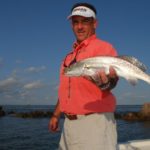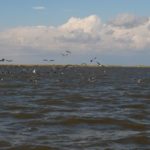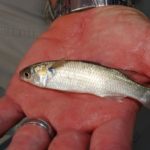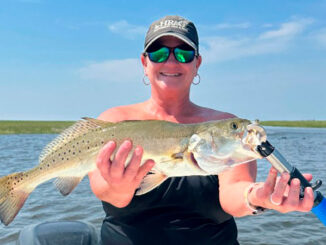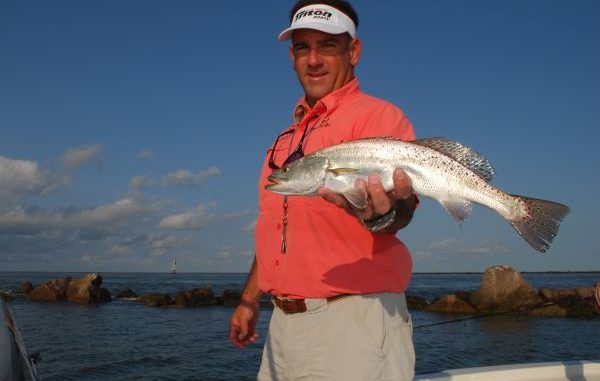
Lake Calcasieu, locally called “Big Lake,” on the western end of the state anchors a speckled trout fishery known for producing large fish.
It shares with Lake Pontchartrain the distinction of having produced three of the top 10 largest speckled trout in Louisiana’s official records program.
Neighboring Sabine Lake, on the Texas-Louisiana border, has produced another top 10 fish, but for some reason the lake (which is actually larger than Big Lake) has received very little attention from Louisiana anglers.
Our two experts were chosen from opposite shores of the lake. Erik Rue of Calcasieu Charter Service (337-598-4700) charters from the community sometimes called “Hebert’s Landing” on the lake’s eastern shore. Bobby Stansel, who with brothers Kirk and Guy operate Hackberry Rod and Gun Club (337-762-3391), is based in Hackberry on the lake’s western shore.
Both men were hopeful about the 2014 season, but 2013 gave them little to cheer about.
“Terrible,” blurted Rue when asked about last season. “The worst on record. It just wasn’t a good trout year.”
He said the fishable area is actually shrinking, making it more difficult to be successful on a consistent basis.
“Big Lake is not a big place, even smaller now that we have had water-control structures put in place controlling ingress and egress from the surrounding marsh,” Rue said. “In early 2000 we were experiencing increasing fishing pressure and shrinking area, but we had a big number of big trout — although not very many fish number-wise.
“A trip might include six fish over 6 pounds out of 20 or 30 fish for the whole boat. That was fine because everyone was happy with big fish.”
And then Hurricane Rita hit the area in 2005.
“Like after any hurricane, fishing got better, plus it knocked out the water-control structures,” Rue said. “But in a couple of years, the control structures were back in place, and since then each year has gotten successively harder.
“Early fishing last year — February and March — was good, and as the season progressed I thought it would get better. It didn’t. Bird schools became very small. Few fish were in them.”
And there’s another reason for the difficulties.
“The last two years has seen a real surge in the numbers of guides on the lake, and the private boat fleet has definitely increased,” Rue said. “The marina lot is filled every day of the week. It’s hard to say if the fishery has suffered because the increased number of boats has divided the catch among more and more boats or not.
“I feel it is all of the above: increasing pressure, the closing off of the marsh and a let-down after the hurricane.”
Stansel’s report wasn’t as negative as Rue’s, but neither was it rosy.
“(2013), until the fall, was sporadic — no pattern,” he said. “If we found fish biting, it would last one or two days; then the hunt was back on. A pattern used to last a week or so.
“It was a good thing we have a lot of boats (the lodge runs 15 charter boats) to help each other find fish. A fella with one boat had to make a lot of friends — fast. In a typical spring, we fish the southern end of the lake. (In 2013), we had to fish the whole system: Turner’s Bay, Lost Lake, Prien Lake and Lake Charles itself. We put a lot of miles on the boats. When we did find fish, the numbers could be good, though.”
Stansel said sizes could have been better.
“Trout sizes were average to below average,” he said. “But you have to figure in wind. We had our March winds in May and June. With the first cold snap in October, the shrimp moved out of the marsh and the fishing turned on, so we had a typically good October and November.”
Stansel noted that they ended up seeing a lot of trout at the end of the year, which makes him hopeful for a good 2014.
“We saw decent-sized fish in the fall but didn’t see a lot of huge trout, so that’s probably what we will open with,” he said. “But getting to where the fish are — over the deeper reefs — is controlled by the weather.”
Rue predicted that speckled trout will be a little more scattered than usual early in the year. Like Stansel, he noted that he was seeing a lot more trout to the north in places like Prien Lake and Lake Charles.
“When I started, I never thought of going north of the Intracoastal Waterway,” Rue said.
Making a prediction for this season is complicated by what he called the “elephant in the room:” the Lake Calcasieu oyster fishery.
“For years it was a tong-only fishery. Then six or seven years ago the use of hand dredges was approved, and it made oystering easier,” Rue said. “Now after two or three years of changing regulations and increasing numbers of oyster boats, it is hard to find oysters in the southern end of the lake. We are no longer fishing over living reefs. I don’t know what the biological effect of this is.
“I’m hoping that we had a good spawn. We had a lot of small fish early in the year, but that kind of evaporated. We didn’t see many little fish in the fall, but that’s kind of normal so I’m not alarmed by the lack of small fish. I am more concerned about the number of small fish that I see early surviving to become keepers.”
Both men expect to spend more time on the middle to north end of the lake in April. Rue is looking to follow what he calls a recent trend and throw big plugs for big trout in Turner’s Bay.
Stansel’s recommendation is similar — throwing suspending Corkys and MirrOdines or slow-moving plastic on jigs over oyster reefs in Turner’s Bay.
Stansel added that Commissary Point can be good in April, as can the man-made reefs in the middle of the lake.
In May, Stansel is still fishing the same lures as in April, adding in topwater baits like MirrOlure She Dogs and Heddon Super Spooks, which rising water temperatures have made effective.
Rue noted that wade-fishing dies out during May because speckled trout move off the lake’s shorelines.
“You find the mullet; you find the fish,” he said. “They should be over those big beautiful reefs on the south end of the lake that we don’t have anymore.”
Most of the May fishery is with plastic and jigs, although plugs will still work.
Rue said June begins the big shift to live bait use — mostly live shrimp under corks. The fish can be anywhere in the lake, he noted, but if dry weather patterns persist many fishermen will begin making more trips north of the lake.
Besides live bait, Stansel recommended using jigs without corks, although he still throws some Corkys.
The reefs off the eastern shore of the lake such as Grand Bayou and Lamberts Bayou are productive, as is the south shoreline to the old jetties. West Cove is also a good area to fish during the month.
July fishing, both men agree, is dominated by the use of live bait. Early in the month, the trout can be scattered, but with the full heat of summer, the fish will move toward the ship channel — especially in the southern part of the lake.
